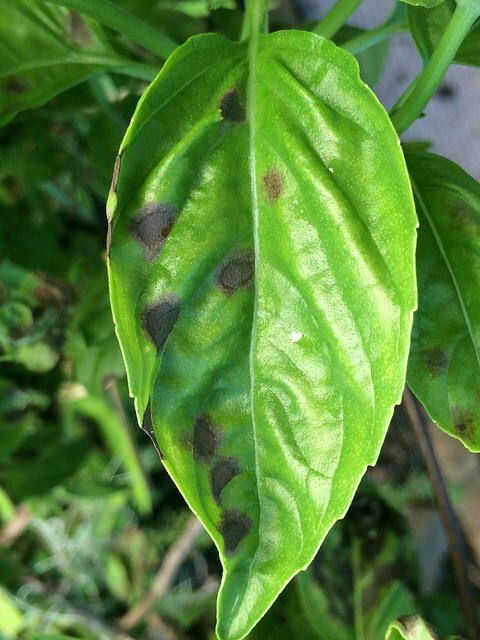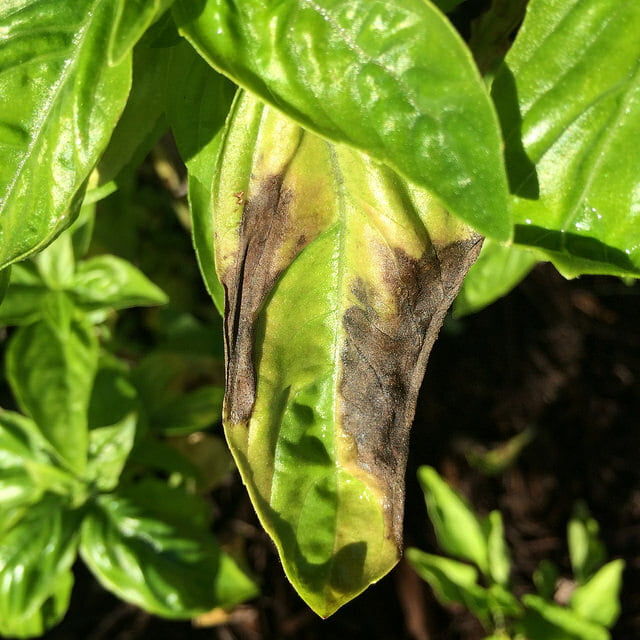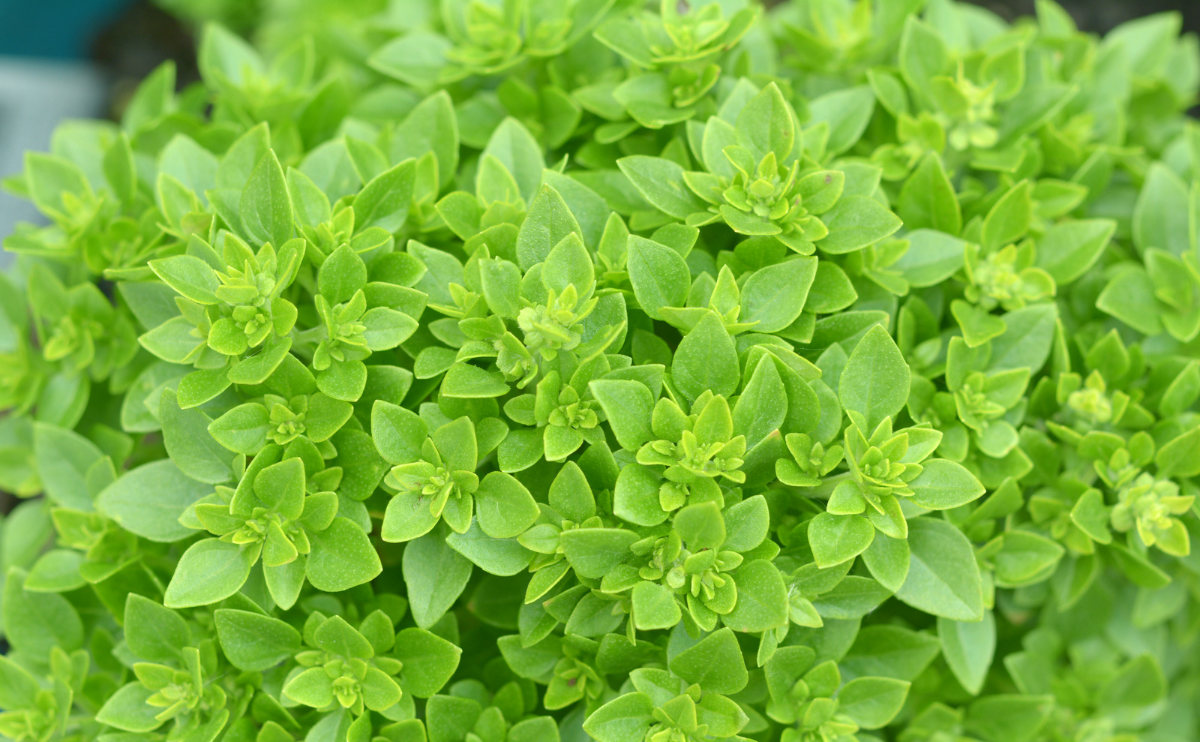Basil plants are one of the most popular herbs to grow and also one of the easiest. Greek dwarf basil has been in use for centuries. It was planted in the Mediterranean area where it became established and is much used, eventually making it to the U.S. where it grows prolifically as well. The extremely aromatic leaves also have a delightful variety of flavors, from the slightly lemony mint of sweet basil to cinnamon and licorice. Leaf colors span from rich green to deep purple, with smooth or crinkled leaves. The flowers are insignificant but very popular with bees.

All types of basil grow easily in warm, sunny weather. The leaves are commonly used in cooking, but the flower buds are also edible. This fast-growing herb thrives equally well in gardens and containers. With sufficiently warm weather, new basil plants are ready for pruning (to encourage bushier growth) in about six weeks.
| Common Name | Basil |
| Botanical Name | Ocimum basilicum |
| Family | Mint |
| Plant Type | Perennial or annual herb |
| Size | 18–24 in. tall and wide |
| Sun Exposure | Full sun (likes some shade in very hot climates) |
| Soil Type | Somewhat rich soil |
| Soil pH | 5.1–8.5 (acidic to alkaline) |
| Bloom Time | June to frost |
| Hardiness Zones | 10–11 (grown as an annual elsewhere) |

When to Plant?
This will be determined by your planting zone. There is a final frost date for each area. As a result, you can plan your gardening activities around this date. Check our Frost Dates Across North America: First & Last Frost Dates Chart. However, the date will not be the same for every plant. Basil should be planted after the last spring frost. You can plant during the summer as well.
How to Plant
To plant basil seeds, you need a 0.25 to 0.5 gallons pot or large container at least 6″ deep so that the basil shoots can grow at least 4″ apart. A container for growing basil must necessarily have drainage holes.
If your container does not have drain holes, add stones to the container’s bottom to act as a drain. Plant basil in well-drained, fertile soil with direct sunlight for at least 6 – 8 hours a day.
The soil temperature for planting basil should be 50°F – 70°F. The first sprouts of the basil will appear in 7 – 12 days.

When growing basil, it is best to use larger pots. The smaller the pot, the more often the plant needs to be watered. On hot summer days, the soil can dry out, which will harm the plant. A sunny windowsill is an ideal spot to grow basil. The best time to plant basil is late in the day or early morning so that the plant is not immediately exposed to the scorching sun. Companion planting: Plant basil among other herbs and vegetables with similar lighting and watering needs, e.g., parsley or tomatoes. Some people say tomatoes taste better when they neighbor basil. Plant basil alongside chamomile, lettuce, oregano, and peppers.
How to Cultivate
Sun – Needs at least six hours of sun per day.
Spacing – If planting more than one, space the basil plants about 4 inches apart to allow for growth.
Water – Large beds or planter boxes may only need water every 3 – 4 days.
Soil – Basil loves moist, rich, well-drained soil with a pH of 6.0 – 7.0.
How to Harvest
When propagated by seeds, the crop is harvested in about 2 – 2.5 months from the appearance of the first shoots.
Once the basil plant is 6 – 8 inches tall, you can harvest it.
Basil has no specific harvest time – just choose any time you want, and do it the way you want it.
Another nice thing is that the more often you harvest, the more basil you get.
Harvest before the seeds form. When basil goes to seed, the leaves will often have a bitter flavor.
Hydroponics
Germination: Plant the seeds in a soilless growing medium, keep it moist, and place it in a warm and well-lit area.
pH range: The ideal pH range for growing Greek basil hydroponically should be between 5.5 and 6.5. This is slightly acidic, which is ideal for the plant’s nutrient uptake.
EC: Should be between 1.0 and 1.6 mS/cm. This measures the concentration of nutrients in the water and can be adjusted as needed throughout the plant’s growth cycle.
PPM: Maintain PPM (parts per million) range for growing Greek basil hydroponically between 800 and 1200 ppm. This also measures the concentration of nutrients in the water, and can be adjusted as needed based on the plant’s growth stage.
Humidity: Recommended humidity range for growing Greek basil hydroponically is between 60% and 70%. You can use a humidifier to maintain this level of humidity, especially during the plant’s early stages.
Light hours: Greek basil needs between 12 and 16 hours of light each day to grow well.
Temperature air: The ideal temperature range for hydroponic Greek basil is between 65°F and 80°F (18°C and 26°C) during the day and between 55°F and 70°F (13°C and 21°C) at night.
Temperature water: The water temperature for Greek basil hydroponics should be between 65-75°F. You can use a water heater or cooler to maintain the desired temperature.
With these guidelines, you should be able to grow healthy Greek basil plants hydroponically. Good luck, and happy growing!
Common Pests and Diseases
Cercospora leaf spot (Cercospora ocimicola)
Symptoms: Circular to irregular dark spots on leaves with light centers
Cause: Fungus
Management
Avoid overhead irrigation and splashing plants with water, instead water plants from the base and apply a layer of mulch around the plants to reduce water splash; remove and destroy any symptomatic leaves; minor infections can be controlled by spraying weekly with a fungicide containing potassium bicarbonate

Downy mildew (Peronospora belbahrii)

Symptoms: Yellowing leaves; discoloration often begins around the middle vein and spreads outwards; gray fuzzy or downy growth on the lower surface of the leaves; brown to black angular necrotic patches on the plant.
Cause: Fungus
Management
Grow tolerant varieties; apply protective fungicide; ensure good air circulation around greenhouse grown plants; use drip irrigation to avoid wetting foliage.


